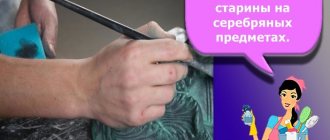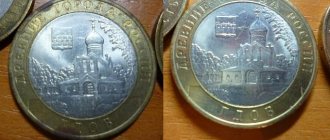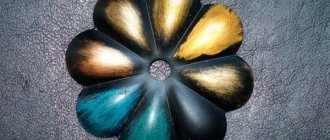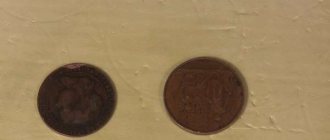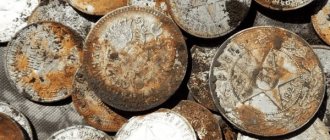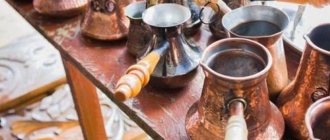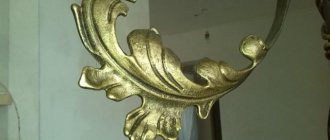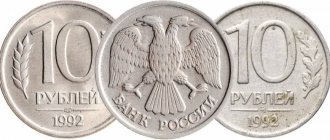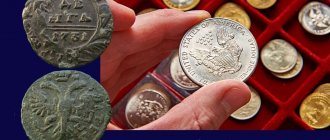The fabulous charm of the ancient cities of Europe is given not only by the exquisite ancient architecture, but also by the tops of the towers of an attractive green-blue color. This natural color of bronze is given by patina - a coating formed on copper, its alloys or other metals subject to oxidation. The bronze sheets that cover the domes and tops of the towers are initially dark brown in color. But after a few years, emerald islands begin to appear in the chocolate sea, which, growing, gradually hide the former color under a bright film.
The word “patina” comes to us from the Italian language, which inherited it from Latin, where patina is a small piece of utensils made of bronze. Oxidation processes create a patina consisting of many layers, but in conversations the word “patina” most often means only the top of them.
Not only dishes, but also coins were made from bronze. Therefore, people quickly became familiar with the patina on money. Patina is a natural and irreversible process. It can only be slowed down by preserving the item in an environment where oxidation will have an extremely gentle effect on it. That is why numismatists recommend storing coins in sealed capsules.
Patination of copper coins with sulfur ointment
To demonstrate various methods of applying patina, modern coins will be used - 1 US cent. This coin is minted from copper, like many ancient coins. And most importantly, you can try different patination methods on several completely identical coins and compare the results.
Sulfur ointment is applied to the coin and literally within a few seconds it turns dark. After treatment with sulfur ointment, its residues must be washed off with soapy water. The patina resulting from the sulfur ointment has a fairly rich black color. The resulting patina is not quite durable and if you rub the coin with felt it will wear off, this should be used to give the coin a more prominent and contrasting appearance.
Patina on zinc coins
Zinc patinated coins have the most deplorable appearance. Shown above is a selection of small denominations from Denmark, the Netherlands and Luxembourg from the First and Second World Wars. In difficult times, metal becomes a strategic raw material, so coins have to be made from the cheapest material. Patina causes zinc coins to darken to such an extent that it is sometimes difficult to make out the designs and inscriptions on them. It is not surprising that after economic recovery, all these countries abandoned zinc coins, choosing other metals and alloys.
Patination of copper coins with ammonia vapor
In order to apply patina to a coin using ammonia, place the coin in a closed container with ammonia vapor for 10-30 minutes, but do not allow the coin to come into contact with the liquid. From a technical point of view, everything is simple, but when it comes to implementation, some difficulties may arise.
While preparing materials for this article, 2 coins were hopelessly lost. To prevent this from happening, follow these simple recommendations:
- Since ammonia has a strong odor, patination should be done in a closed jar or container.
- The coin must either be hung, secured by the edge, or placed on any object inside the container, but not just placed, but on a cotton pad, this will allow the coin to become covered with patina evenly on both sides.
- You need to pour a little ammonia (5-10 grams) into the bottom of the container; it is best to do this at the very end after the rest of the preparations and immediately close the lid.
- Under no circumstances should you heat a closed container; this will cause condensation to form on the coin and cause a very uneven patina.
Vapors from ammonia literally cover the coin in just a few minutes with an even layer of patina of a pleasant brown color. The coin stops shining and looks very attractive. If the coin is left for several hours, the patina does not become more saturated, but pockets of corrosion begin to appear.
Patination of copper coins with potassium permanganate and copper sulfate
Patination of coins in a solution of copper sulfate and potassium permanganate gives quick results and a pleasant brown patina. A coin or other object must be immersed in a boiling solution for 1-2 minutes.
To prepare the solution, it is best to use distilled water, for one glass of water (200 ml) you need to add 1 gram of potassium permanganate and 1 gram of copper sulfate, mix the solution thoroughly and place it on the stove in a container that you don’t mind - after patination of the coins, you most likely won’t be able to wash the container .
The longer the coin is in the solution, the darker the patina you can get - after 10 minutes the patina becomes almost black. The 1855 penny from the example spent about 1 minute in a boiling solution. Also shown is an image of the coin before cleaning it with Trilon-B.
"Cabinet" patina
Even proper storage does not provide complete protection against oxidation of the metal surface. However, the difference in the final result can be noticeable. If the coin is stored in a hermetically sealed capsule that limits the access of air as much as possible and is made of non-aggressive material, the oxide film will lie on its surface slowly and carefully. This is exactly the patina that is called noble. In some cases, experts call it cabinet work.
The word “cabinet” in this context does not mean a room, but special cabinets made of varnished wood with drawers lined with velvet - the so-called münzkabinets, used by numismatists of past centuries. Velvet and wood, by and large, did not serve the function of high-quality storage, but served more for the effective presentation of the collection. When stored this way, the coating turned out to be beautiful, but quite thick. This subsequently gave rise to the term “cabinet wear,” applied to specimens that were not in regular circulation but were not stored in the best possible manner.
Patination of silver coins with sulfur ointment
Silver coins do not need as much patina as copper coins, but silver coins often sparkle white after cleaning and require a patina to achieve an older appearance.
To apply patina to a silver coin with sulfur ointment, almost the same operations are carried out as on a copper coin, but there are differences. First, the coin should be cleaned in ammonia or citric acid so that the surface is clean and there are no uneven areas. Next, sulfur ointment is applied to the coin, applied in an even, thick layer. Since silver is much less chemically active than copper, patina forms much more slowly. To speed up the application of patina, the coin must be heated; at home, the best way to do this is to place the coin on a cotton pad or soft cotton cloth and heat it with a hairdryer. In 1-2 minutes the silver coin becomes completely dark. Afterwards, the coin must be washed with soap to remove any remaining ointment.
After applying the patina, the coin was rubbed with felt so that the patina on the protruding parts of the coin was a little erased and the relief was more clearly visible. For this coin, such an operation gives a more advantageous appearance, but for heavily worn coins it allows you to raise the relief and sometimes distinguish details that were not noticeable before.
How to determine that the patina is artificially induced:
- Too sharp transitions from dark to light places, excessively dark color in hard-to-reach places of the relief and along the edge of the coin field circumference.
- Shine. Genuine patina is always matte and has no shine.
- Presence of shades unusual for metals. The most common example is the red tint of brass, which unmistakably indicates the use of chemicals.
- Upon closer examination, it is possible to distinguish cavities or scratches under an even film of plaque.
- The distribution of patina depends on the height of the relief, while in the natural case this does not happen.
An artificially aged coin does not add value; numismatists even claim that a true collector feels the “soul of the coin,” its noble gray hairs. Such a statement is equally difficult to prove and refute, so we can only talk about physically obvious parameters. The only acceptable exception to artificial processes is the method of accelerated oxidation in a natural environment, but this still takes many years.
Patination of silver coins with egg
This is the simplest method of patination; no reagents are needed at all; in addition, the process is not fast and you can always settle on the desired degree of patina.
To patina with an egg, you will need to hard-boil one chicken egg, when the egg has cooled to a temperature slightly above room temperature, you need to peel it and put it in a container (ordinary plastic with a lid), then put a silver coin or several in the container and close the lid. It is better not to use a hot egg as it is not convenient to clean and steam comes from the hot egg and condensation may form on the coin which will lead to uneven patina. It is worth noting that it is advisable to first clean the coin with ammonia or citric acid so that the surface is completely clean and the patina lies evenly.
These 5 stamps were patinated with egg for five hours in a closed container, during which the coin was turned over several times. A coin patinated with egg produces a very specific patina, the so-called rainbow, it is very durable and shimmers in different colors depending on the viewing angle.
Patina on gold coins
Pure gold is a metal that is practically not subject to oxidation. This section appeared only because pure gold was not used for everyday coins of past centuries because of its softness. To give gold strength, it was alloyed with a small amount of other metals (usually silver and copper, less often nickel or molybdenum). The five-ruble note of Nicholas II, taken as an example, is 900-carat gold. The alloying additive to it is still the same copper. Under certain conditions, copper can appear on the surface, and even such a small amount will cause the coin to darken in fragments (as in the illustration above).
More often on gold you can find rust stains, caused by the same oxidation process. During minting, chipped microparticles of the stamp may become pressed into the surface of the gold, and after a few years the coin will become unsightly. In Russian numismatics, the most famous are the rusty gold “Victory Bearers”. After the scandal with SPMD gold coins, Russian minting technology was improved, and such defects began to occur much less frequently. Both rust and patina always reduce the value of gold coins.
Patination of bronze/brass coins by electrolysis
In most cases, bronze or brass coins do not need additional patina, this is due to the fact that they are naturally quickly covered with a strong protective film of oxides and are perfectly preserved in this form.
But sometimes, during the cleaning process or when stored for a long time in the ground or in improper conditions, coins become covered with uneven spots with a patina of different colors. In other words, when a brass coin with good relief does not look beautiful, you can try to cover it with a patina using electrolysis.
These five kopecks are a dug coin; oxides of uneven color have formed on it in the ground over decades. Electrolysis was used to give it an even patina. A soda solution was used as an electrolyte, the current source was a charger for a car battery (current 2 A), a coin was attached to “-”, a sacrificial coin was attached to “+” (about the same nickel, it is important that the metal was the same , the same as the coin being processed). Patina application time is 2 minutes. After electrolysis, the coin was ground in soda paste.
Silver is a beautiful noble metal. Products made from it are simply mesmerizing - they shine, shimmer in the light and look like a real work of art. But as soon as you pick up silver or put on jewelry made from it, a rapid oxidation process begins. The metal becomes dull and loses a fair share of its attractiveness.
Therefore, many people prefer to darken silver. On the one hand, such products become like antiques, covered with a layer of patina. On the other hand, shiny silver with dark inclusions looks more attractive.
Patina on aluminum coins
Aluminum was often used in coinage in the 20th century. Basically, small denominations were made from it (for example, Hungarian fillers). In the GDR, the entire line of coins, with the exception of the heavy brass 20 pfennig used in the machines, was aluminum. The oxidation process quickly deprives the aluminum coin of its stamp shine. It becomes dull and inconspicuous, acquiring a matte gray coating. And if the protruding parts of the relief are still mechanically cleaned during circulation, then the coin field very soon begins to look dirty.
Blackening and oxidation
How to darken silver at home? There are two ways to do this: oxidation and traditional blackening. And the difference between these two methods is colossal.
During oxidation, silver is covered with a thin film of oxides, so the product receives a dark coating. But the coating is short-lived and easily erased. The difference is especially noticeable when cleaning - if you polish oxidized silver, it becomes covered with a network of lighter spots.
Blackening is the coating of a metal surface with a mixture of silver, copper and lead sulfides. This coating is resistant to abrasion and completely disappears only with prolonged boiling or exposure to acid.
Blackening on an industrial scale is carried out in various ways. But, as a rule, they all involve applying a powder from a mixture of silver, copper and lead sulfides to the product. The patina is fixed using the “dry” or “wet method” - in the first case, the product is fired after applying the powder, in the second, the metals are diluted with water to a creamy state, and the silver, after applying the mixture, is heated in a muffle furnace.
If we talk about how to darken silver in general, then experts identify the following methods:
- galvanic - this technology requires the presence of special equipment, so it is not used at home;
- mechanical - using graphite;
- chemical is the most reliable blackening method.
Metal oxidation
This term applies to cases where the specimen has been in the ground for a long time, simply in the air, in a damp place or in another extremely aggressive environment. The resulting patina from such storage is rough, thick and unsightly. Moreover, it is no longer a thin film of plaque, but eats into the metal itself and becomes an inseparable part of the coin. If it is cleared of patina, but it is not smooth and even, grooves will be visible in it and reliefs may become indistinguishable. In the most advanced cases, the metal crystallizes completely, i.e. virtually disappears, and the coin disk is one continuous patina.
Dirt clogged into the grooves of the relief is sometimes mistaken for patina. They can be distinguished by their coverage area. Real age-related plaque always affects part of the smooth field, and dirt accumulates in the folds of the pattern.
Mechanical method
How to darken silver at home with graphite? This is a fairly simple technology, and its result is due to the same processes that occur with lunar metal over time. That is, dust particles stick to it and firmly “eat” into the recesses. Using graphite you can simply speed up this process.
To blacken the product, they are lubricated with a mixture of graphite powder, iron oxide and turpentine, diluted to a pasty state. Then wait for it to dry completely and wipe the silver with a soft cloth. The older the product, and the more uneven its surface, the more noticeable the result will be. But in general, such blackening is less durable than that obtained by chemical or galvanic methods.
Blackening with an egg
How to darken silver at home with an egg? The technique is quite simple and you do not need to buy any additional funds. Everything you need is already in the refrigerator. So, to blacken with an egg you need to do the following:
- Boil an egg or two if you have a lot of silver jewelry.
- Separate the protein - it can be eaten, as it does not participate in the creation of a noble coating. All the substances needed for blackening are concentrated in the yolk.
- The yolks must be placed in an airtight container and crushed.
- Next, you need to place the silver in the same container, but so that the metal does not touch the yolks, otherwise the blackening process will take place too quickly and unevenly. Therefore, decorations must either be hung or laid out on a wire rack, or, as a last resort, insulated with a paper towel.
- The products should be left with the yolks in a tightly sealed container for a day. If after 24 hours the result does not look very impressive, then you can leave the silver for another 1-2 days.
- Remove the items and wash them with soap.
- Polish all protrusions with a soft cloth.
Harmonious interior
To make a set with a silver patina a highlight of the design of your favorite home, try using the following decor options in the interior.
You may want to use pictures in heavy silver frames or a beautiful mirror for decoration. A silver cream jug on an open shelf above the table will harmonize beautifully with the patina of the white set.
All kinds of metal utensils and household appliances will look good in such a house. Metal lamps, both general lighting and additional, can be chosen to be of extraordinary beauty, and the kitchen in the house will turn into the most stylish and elegant room, loved by all household members.
Kitchen white enamel with silver patina
How to make such a furniture set become the key center of the design solution? There are two key points here: the absence of an excessive amount of bright interior details and proper lighting of the space.
Variegation and dim lighting are not the best option for such a beautiful and unique furniture set. Make sure that your purchase does not get lost in an inappropriate environment, and also think through the lighting system in advance.
Uses of iodine
How to blacken silver at home with iodine? When using this substance, the product must be cleaned first. Then apply an iodine solution with a cotton swab or cotton swab and put the silver to dry, best in direct sunlight.
When the metal darkens, you need to clean it with toothpaste - it will replace a mild abrasive. After cleaning, the bumps will shine, but the grooves will remain darkened. If the result is far from perfect, then the procedure must be repeated the required number of times.
The disadvantages of this technology are obvious: this blackening method is suitable for embossed products, but is not suitable for jewelry with a smooth surface.
Sulfuric ointment
You can quickly and effectively darken silver using sulfur ointment. This is a medicine that is mainly used to combat scabies pathogens in both humans and animals. Therefore, it is sold both in veterinary and regular pharmacies.
Sulfur ointment is thick, yellow in color and has a rather unpleasant odor. It must be applied to the product, and then heated to a fluid state using a hairdryer. After the ointment has transformed into a more liquid state, it can be more carefully distributed on the surface of the silver. When heated, you will see how the metal acquires a rich black-blue or purple color. Afterwards, the product can be wiped dry; if necessary, the procedure can be repeated.
Also at home, in order to darken silver, they use “sulfur liver” - a sintered mixture of sulfur and soda, which is thrown into water with silver. But it is not recommended to use this blackening technique at home, since the process will release hydrogen sulfide, a dangerous gas with an unpleasant odor.
TYPES OF PATINA
There are 3 types of patina:
- Metallized patinas. These are golden patina, silver patina, champagne patina, bronze patina, copper patina.
- RAL patinas. These are patinas that repeat various shades of enamels from the RAL catalog (white patina, black patina, gray patina, ivory patina, green patina, etc. according to the RAL catalog)
- Wood color patinas. These are patinas applied to the surface of solid wood or veneer. The most common among them are: walnut patina, dark walnut patina, cherry patina, antique patina
How to clean blackened silver?
Applying dark plaque is much easier than removing it later. In order to get rid of blackening, you will have to make a lot of effort, and most likely you will turn to specialists for help.
But if you need to clean blackened silver while preserving the noble dark coating, then such a procedure will require special care. First of all, you need to give up brushes and use only soft cloths for polishing. This way the relief will remain darkened and the bumps will remain shiny. Toothpaste can be used as an abrasive. The blackened product cannot be boiled or cleaned with caustic substances.
And in cases where you take a patinated piece of jewelry to a workshop for cleaning, you need to warn the jeweler that you need to preserve the noble patina.
Hello, dear readers. In the next article we will tell you what patination of coins is and how to do it. Cleaning and patination of coins are almost always related to each other. Often, after the cleaning process, we get an unnatural shine of the coin or an unpleasant shade of color. “Now take half off the original price,” forum experts grumble, looking at your freshly cleaned copy. A coin patina tool or manual application of patina will help return the coin to its usual appearance. The methods for patination of coins depend on the metal with which we have to work.
Patination theory
The word “patina” seems to us to be natively Russian, like “old times” or “homeland,” but it came to us from the Italian language. It appears due to a chemical reaction that transforms the surface of the coin. On silver or copper, the patina looks beautiful, while the patina on an aluminum coin is a cloudy film, which is why such coins lose value. A patchy or partial patina also does not add charm to the coin. Therefore, the patina that disfigures the appearance of the coin is removed. It should be remembered that patina is part of the coin
. If the oxidation processes affected the deep layers, then after cleaning, instead of a coin, we will get a thin plate with shapeless potholes instead of a pattern. But even well-preserved coins can look unsightly after cleaning. This is especially true for copper coins, which take on a striking red color. However, you can return the coin to the appearance of undisturbed antiquity. This is done by patination - the process of creating an artificial patina.
Availability of patina induction
To an unprepared collector, it seems that in order to achieve patina you need to be almost a medieval alchemist or work in a large chemical laboratory. This is wrong! Most patinas are achieved using simple methods using readily available ingredients. Despite the fact that patination of coins is the application of an additional layer that gives the surface of the coin a beautiful color, the defects of the coin are induced patina
will not hide. Dark spots, potholes, nicks, smudges, etc. will remain in place, they will just change color. According to experienced collectors, artificial patina will not add anything to the price of the coin. But the patina induced by experienced hands is no different from natural, and the coin takes on a very attractive appearance in the eyes of potential buyers. The processes for inducing patina for different metals have fundamental differences. Simply put, there is no universal method. Let's look at some.
Patination of copper coins
There are many ways to apply patina to copper. A very popular method is using manganese and copper sulfate. If there is only a standard package (3 grams) of manganese, then take 10 grams of copper sulfate per half liter of water. If manganese is taken in an amount of five grams, copper sulfate will need 20 grams per liter. Heat the solution to 90 degrees. When the desired temperature is reached, place coins in the solution. The temperature should be controlled by warming the solution and periodically turning the coins over. The result: a wash-resistant bright brown patina. Pay attention to the toxicity of vitriol and take the precautions required when working with toxic substances.
A fixer (sodium hyposulfite) is used to create a patina on clean and grease-free coins. Soak the coins in the solution for 10 seconds to half a minute. Removed coins are wiped with a cloth. When the coin dries, the patination will give it a bronze color. The simplest way is to heat a coin in the flame of a gas stove burner, when the experimental specimen turns light brown. Copper plating is also an easy option, although less popular. Patination of coins with sulfur ointment is also not a complicated method. Work must be carried out in water. A coin rubbed with ointment receives a dark brown or grayish patina. To brighten, after a forty-minute pause, the coin is first polished with a napkin and then washed with a soapy brush. Experts do not recommend sulfur ointment, but it is quite suitable for experimenting with simple methods.
Patination of silver coins
It is recommended to patina silver with ammonia (an ordinary bottle of ammonia). The coin is placed in the freezer for half an hour. Fixing the experimental specimen by the edge with tweezers, we hold it for a minute to three over the open vial. As soon as the coin acquires the desired gray color. Then we rinse the coin in water and dry it. For those who don't want to bother with ammonia, a simple hard-boiled chicken egg is suitable. It is cut into pieces and covered with a glass jar along with a coin placed on its edge. Patination of coins using this method is quick: the color change is visible to the eye. However, if the color does not suit you, it will not be easy to wash off the patina.
When everything happens by itself
If you apply patina to bronze coins
, then you can use methods suitable for silver.
But there is a way to patina bronze coins naturally. To do this, bronze coins must be constantly exposed to sunlight. The sun helps to obtain a beautiful and even patina on bronze in one and a half to two years. Of course, this method cannot be called an express method, but you don’t have to wait half a century either. Returning to copper, remember the advice to keep cleaned coins in a jar of matches. The results are ambiguous, but you can experiment with inexpensive copies. At home, they try patination with wood. Certain types of wood produce tannins, which contribute to an “armchair-like” patina
.
If the alloy from which coins are minted contains copper or any of its compounds, then sooner or later a film will appear on the surface of the metal - patina. It has a variety of colors and shades, and its appearance is due to the oxidation process of copper. It is also called noble rust, and all because the coin in such a shell is not subject to corrosion and has an attractive spring appearance. Patina is prized by collectors as it gives a collection a subtle antique feel.
If a coin needs cleaning but ends up losing its patina, don't worry. Artificial patination
which can be done even at home. Now there is no need to wait many months for the patina to appear naturally.
BRIEF RECOMMENDATIONS FOR WORKING WITH RAL PATINA
has developed a universal program for the production of colored patinas according to the RAL catalog.
RAL patina is a solution of special pigments in a mixture of solvents with the addition of binders and adhesive additives.
RAL patina repeats the enamel color according to the RAL catalog, but allows you to give the facade an aging effect.
General recommendations for working with RAL patina correspond to recommendations for working with gold patina.
Despite all the variety of patina colors offered, the most popular among furniture makers are:
– ivory patina (AE 69.010)
— white patina (AE 61.000)
— black patina (AE 60.109)
- green patina (AE 61.018)
— gray patina (AE 61.019)
— brown patina (AE 68.007)
Patination of metal banknotes containing copper
Patination of copper-containing coins is possible in three ways.
- The first option requires 20 grams of copper sulfate and 5 grams of manganese. They are dissolved in a liter of water and then heated to 90 degrees. It is necessary to carefully monitor the temperature, avoiding boiling, as otherwise the result is not guaranteed. Prepared coins are dipped into the hot solution, turning them over from time to time so that the patina is layered evenly. It is impossible to say exactly how long it will take you to fully patina, since there are many options for the desired color. Some people need a dark brown coin, while others need a reddish tint.
- For the second option, you will have to go to the pharmacy to buy sulfur ointment. Generously coat the coin with this ointment and set aside for 3-5 minutes. With this method, patina forms very quickly, almost instantly. To prevent the metal from turning black, it is better to carry out the procedure near a water tap. As soon as you see the coin turning brown, rinse off the ointment thoroughly. Didn't make it on time? There's no need to get upset. Take Vaseline or vegetable oil, soak a soft cloth in it and polish the coin to the shade you require.
- The third patination option is possible in the presence of sodium hyposulfite, which can be purchased as a fixative for developing photographs from film. Lightly heat the 10% solution and place a clean and pre-degreased coin in it for 10-20 seconds. The resulting brown tint will not only please the eye of a professional numismatist, but will also reliably protect the metal from corrosion. This method can also be used for patination of bronze items.
How to Patina Brass?
To age copper or brass, you will need sandpaper, which must be used to carefully treat the surface of the product. After sanding, you can apply a chloride patina solution to the product. You can also dip a product that needs patination into this solution.
Interesting materials:
Why do the leaves of male happiness turn yellow? Why do radish leaves turn yellow? Why do spathiphyllum leaves turn yellow? Why do citrus leaves turn yellow? Why do the lower leaves of orchids turn yellow? How many copyright sheets are there in the book? How long does a stop list last in Sberbank? How many days of sick leave is paid by the employer? How many pages should there be in a dissertation? How many calories are in one sheet of pita bread?
Patination of coins containing silver
- Applying a new patina to silver-containing metal is fairly easy. To do this you will need ammonia or regular ammonia. Place the coin in the freezer for twenty minutes or half an hour. After the allotted time, carefully take the money by the edge with thin tweezers and bring it to the open bottle of ammonia. A miracle will literally happen before your eyes: the coin will turn grayish due to the emerging patina. Stop working on the specimen as soon as it reaches the desired shade.
- An even simpler way is to use... a boiled chicken egg. After it is hard-boiled, the egg is cut and placed in a container with a fairly narrow neck. The coin is also sent there. Under the influence of hydrogen sulfide, silver changes color, becoming covered with a patina. This method is good because it achieves the most uniform coverage, without tweezer stains.
Patination of coins containing bronze
As mentioned above, to apply a new patina to metal containing bronze, a method based on sodium hyposulfite is used. In addition, ammonia and sulfur ointment are used with some haste. Numismatists advise experimenting with ordinary laundry soap, in which a coin is placed in the pulp for 2 weeks.
However, bronze coins are best covered with noble rust naturally, under the influence of sun, wind, and rain. In just one and a half to two years they will have an even and beautiful brown tint.
So, patina can be created artificially, and in some cases this is quite simple to do. However, I would like to warn novice collectors: in professional circles, any intervention in the appearance of a coin is always equated to a flaw and significantly affects the collectible value of the coin. It is advisable not to bring your collection to a state where it requires external patination.
Remember that a specialist can always easily assess by eye whether the patina that protects the metal is real or whether the shell was created artificially. Thus, the original “noble rust” envelops coins in a fairly thick layer, reliably covering chips and scratches. But the remake can be scratched by any sharp object.
Advantages of furniture patination
Let us briefly touch on the main advantages of artificial aging of furniture sets:
- high wear resistance;
- durability;
- uniqueness;
- affordable price.
Disadvantages include easy flammability; we advise you to especially carefully follow fire safety rules, this will give you and your household confidence and peace of mind.
